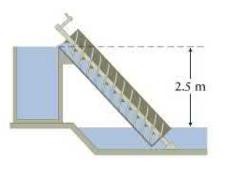Archimedes' screw, one of the first mechanical devices invented for lifting water, is a very large screw
Question:
Archimedes' screw, one of the first mechanical devices invented for lifting water, is a very large screw fitted tightly inside a shaft (Figure P12.72). The bottom of the device is placed in a pool of water. As someone turns the handle to make the screw turn, water is carried up along the ridges of the screw and comes out the top of the shaft and into a storage tank. As the handle turns, the work done by the force exerted on the handle is converted to gravitational potential energy of the water-Earth system. Let's say you want to take a shower using this device. You figure that your shower will use \(44 \mathrm{~L}\) of water, and so you have to raise this amount to the storage tank \(2.5 \mathrm{~m}\) above the pool. Every time you turn the handle, you exert a force that causes a torque of \(12 \mathrm{~N} \cdot \mathrm{m}\). How many times must you turn the handle?
Data from Figure P12.72

Step by Step Answer:






